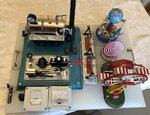vikash23
Full Member level 2
Hi,
I am using a motor that spins at 6000 rpm.
I would like to connect a sensor to the shaft of the motor to test the speed of the motor .
The output of the sensor can be analog or digital.
Low cost sensors that I have seen is capable of measuring only upto 5000rpm.
Can any one please suggest me a sensor module that can perform my requirement.
The working voltage of the sensor. can be upto 24V.
I know i can measure the rpm by using the back emf but I need to measure using the sensor and compare the value with the back emf value.
Thanks.
I am using a motor that spins at 6000 rpm.
I would like to connect a sensor to the shaft of the motor to test the speed of the motor .
The output of the sensor can be analog or digital.
Low cost sensors that I have seen is capable of measuring only upto 5000rpm.
Can any one please suggest me a sensor module that can perform my requirement.
The working voltage of the sensor. can be upto 24V.
I know i can measure the rpm by using the back emf but I need to measure using the sensor and compare the value with the back emf value.
Thanks.

